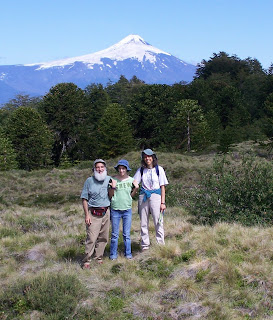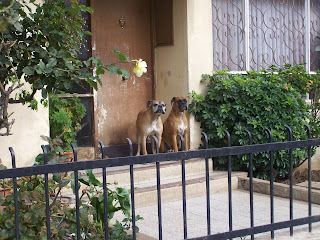Our trip began with a nine hour drive in a rental car down Ruta 5, the Panamerican Highway - the same road that we have driven in Costa Rica and California, which stretches from Alaska to the Chilean island of Chiloé, one of our destinations on this particular journey.
Our first night was spent in Pucón, a picturesque town located on the shores on Lake Villarrica, beneath Volcán (volcano) Villarrica. It has the feel of a western town, like Jackson, WY or Telluride, CO.


One of the guide books says “Pucón boasts the best small-town tourism infrastructure south of
Costa Rica.” From here there is access to hiking, kayaking, whitewater rafting, horseback riding, mountain climbing, fly-fishing, skiing – you name it. In the morning we drove to a remote park – Parque Nacional Huerquehue (pronounced
where-KAY-way) – and went on a four-hour climb to a spectacular overlook with a view of volcanoes, lakes, and
Andes peaks.


The Chilean national tree,
araucaria araucana, is native to this area. It is "a grand old species of pine that can age up to 1000 years. The English name became 'monkey puzzle', since its forbidding foliage and jigsaw like bark would surely stump a monkey." (
Lonely Planet). We've never seen anything quite like it. (check out photo)

After our hike, we stopped for a quick dip at Los Tres Saltos (the three waterfalls). 
 Located on the property of an elderly German-Chilean woman, there was a nominal entrance fee to enjoy her beautiful natural pool - and she also sold fresh baked kuchen. This, surprisingly enough, is a common Chilean pastry in the heavily German-influenced Lakes Region - one sees "kuchen" signs frequently along the road. We made our way the next day through this region, driving down the western side of Lake Llanquihue (yan-KEY-way) from Puerto Octay to Frutillar, where there is a spectacular view of Volcán Osorno across the lake.
Located on the property of an elderly German-Chilean woman, there was a nominal entrance fee to enjoy her beautiful natural pool - and she also sold fresh baked kuchen. This, surprisingly enough, is a common Chilean pastry in the heavily German-influenced Lakes Region - one sees "kuchen" signs frequently along the road. We made our way the next day through this region, driving down the western side of Lake Llanquihue (yan-KEY-way) from Puerto Octay to Frutillar, where there is a spectacular view of Volcán Osorno across the lake.

Some time later, we heard the labored breathing of the Beast once more, and Doktor Fåhrstengrüsse gathered us together for what may well have been the last time. [Just checking to see if anyone is actually reading this.]
From Lago Llanquihue we returned to the Panamericano and headed to the Island of Chiloé, described variously as “a haven of rural tranquility” and a “misty, verdant archipelago,” where “its rolling hills, covered in patchwork fields and thick forests, provide a lasting sense of rural calm.” It reminded us a little of the remote part of the Maine coast – around Machias and Lubec – where we like to vacation.

We stayed at Esmeralda-by-the-Sea, a charming and somewhat rumpled hostal right on the beach in the unprettified but picturesque fishing village of Chonchi. On a tip from the owner, Carlos the Canadian, we went for a hike the next day on Isla Lemuy, a short ferry ride from Chonchi. Our destination was a remote beach, where we were told we might find black swans, and be able to pick wild blackberries. 

 After a 2 hour walk to the beach, during which we gorged ourselves on the heavy bunches of blackberries that grew along the road, we encountered no black swans, but an Aussie couple we had met at the hostel, Mick and Bronwyn. Together we stopped for a cup of coffee at the home of Pedro Andrade, the owner of a campsite on the beach and a small farm where he raises organic vegetables, fruit trees, animals.
After a 2 hour walk to the beach, during which we gorged ourselves on the heavy bunches of blackberries that grew along the road, we encountered no black swans, but an Aussie couple we had met at the hostel, Mick and Bronwyn. Together we stopped for a cup of coffee at the home of Pedro Andrade, the owner of a campsite on the beach and a small farm where he raises organic vegetables, fruit trees, animals.  He offered us a tour of his farm, and spent the entire afternoon escorting us on trails through fields and native woods back to the road that led to the ferry. The weather was beautiful, the landscape dramatic. We sampled Pedro’s apples and tomatoes as well as native fruits he showed us along the way. Here's a picture of Pedro offering us chupón – the sweet fruit of the palm/cactus-like quiscal plant.
He offered us a tour of his farm, and spent the entire afternoon escorting us on trails through fields and native woods back to the road that led to the ferry. The weather was beautiful, the landscape dramatic. We sampled Pedro’s apples and tomatoes as well as native fruits he showed us along the way. Here's a picture of Pedro offering us chupón – the sweet fruit of the palm/cactus-like quiscal plant.

And Shira sampling nalca – the celery-like edible stalk of a native plant with huge leaves called pangue.



We hiked through forests of arayan trees native to the island (very little of these forests remains today), and walked along 300 year old senderos (footpaths) that were used by Pedro’s Mapuche ancestors. Pedro shared his knowledge of Chilote traditions and customs, of the names and properties of native trees and plants; we felt like we had been blessed with particularly good "traveler's karma" to have run across him.
Our "traveler's karma" held up the next day when we journeyed to the northwest (Pacific) side of the island, to see the pingüino colony near Pumillahue. Getting there is not easy; it is 21 kilometers from Ancud, the nearest town, and the last 11 of those kilometers are on an unpaved very rocky road. We picked up a young Chilean couple, Simon and Loreta, who had been able to get a taxi ride only to where the pavement ended. They crowded into our small rental car for the last 12 km, and we wound up sharing a picnic on the beach with them.  They were very sweet, and negotiated Chilean, not tourist, rates with the fishermen who took us out in their boats.
They were very sweet, and negotiated Chilean, not tourist, rates with the fishermen who took us out in their boats.  We saw Humboldt and Magellanic penguins, as well as cormorants and a nutria del mar - a sea otter.
We saw Humboldt and Magellanic penguins, as well as cormorants and a nutria del mar - a sea otter.

The island of Chiloé was the southernmost part of our journey - over 1100 kilometers from Valparaíso. As we began to make our way back north, we took an eastward detour to Lago Todos Los Santos.  There is no road surrounding this lake; one can drive only to the easternmost edge of the lake via an unpaved road. Here the tourist shops and restaurants, that elsewhere dot the shores of the lakes in the Lakes District, drop away and unspoiled wilderness begins. We had spent a good part of this trip admiring Volcán Osorno from afar; here we were able to get up close and intimate,
There is no road surrounding this lake; one can drive only to the easternmost edge of the lake via an unpaved road. Here the tourist shops and restaurants, that elsewhere dot the shores of the lakes in the Lakes District, drop away and unspoiled wilderness begins. We had spent a good part of this trip admiring Volcán Osorno from afar; here we were able to get up close and intimate,  hiking up to a lava field at its base,
hiking up to a lava field at its base, formed by a relatively recent eruption which transformed the area, rerouted a river and created a waterfall (Salto de Petrohué).
formed by a relatively recent eruption which transformed the area, rerouted a river and created a waterfall (Salto de Petrohué).
Our last stop on our northward journey was in the city of Temuco, a gritty, non-touristy down-home Chilean town (that reminded us, for those of you who can appreciate an Israeli analogy, of someplace like Afula - where ordinary people live.)  Temuco, or so the guidebooks say, also has more Mapuche (native) influence than other Chilean cities; we saw this in the street performance of musicians in native garb (didn't get a picture of that), and in the Mapuche musical instruments for sale in the mercado municipal.
Temuco, or so the guidebooks say, also has more Mapuche (native) influence than other Chilean cities; we saw this in the street performance of musicians in native garb (didn't get a picture of that), and in the Mapuche musical instruments for sale in the mercado municipal.  Jonathan bought a trutruka (horn on a long stick), a kull-kull (cow's horn with a woven strap), and a kultrum (drum). The fourth small item in the picture is a pifilka (a wooden whistle), thrown in as a freebie by the vendador.
Jonathan bought a trutruka (horn on a long stick), a kull-kull (cow's horn with a woven strap), and a kultrum (drum). The fourth small item in the picture is a pifilka (a wooden whistle), thrown in as a freebie by the vendador.
The final leg of the trip was an eight-hour drive back to our apartment in Valparaíso. Arriving around 10 p.m., we felt that it was good to be home - and realized that our cozy digs in this exotic yet increasingly familiar city were becoming home for us.











































































